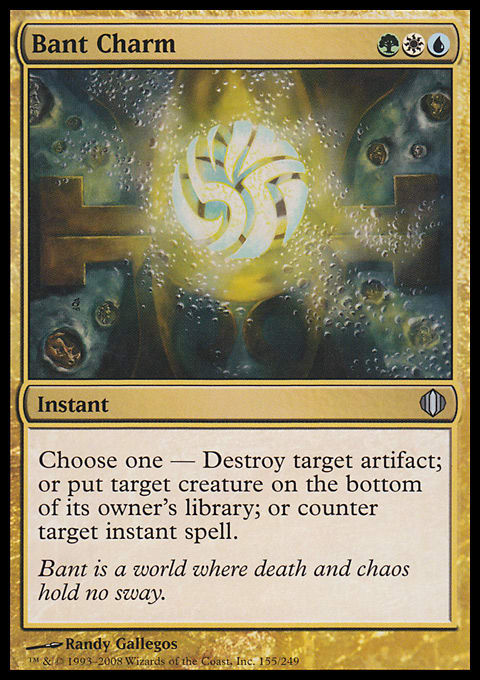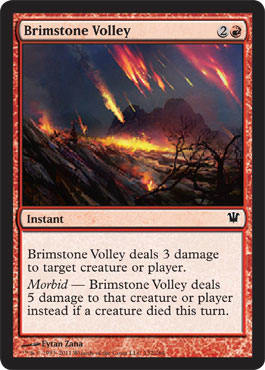One of the most important skills when in a Draft is the ability to pick the card that maximizes your chance of winning the Draft (and not necessarily the best card). In order to further discussions on Limited theory, this article hopes to establish a more cohesive vocabulary to be used in said discussions and to put forth some basic concepts used during the course of a Draft.
Definitions
Before we begin any discussion, it’s best to provide precise definitions for terms that I’ll be using and to clear up some terms that are commonly misused (“opportunity cost” is the biggest offender here) in the Magic community.
1. Opportunity Cost – The opportunity cost of something is the value of the things you give up in order to take a particular set of actions. For example, if you have $1,000 and choose to buy a ticket to Scotland, you forfeit investing that money in something that might actually make your life better or earn a return. That same $1,000 might have been invested profitably in the stock market, and the opportunity cost is the loss of these potential increases in value.
The opportunity cost of any Draft pick is the value lost by not taking the other cards in the pack. If you take a Bloodline Keeper as pick one in pack one and pass a Spider Spawning (and have LSV or Tom Martell in your Draft), you are giving up the value of having that Spider Spawning in your deck.
2. Set – A set is a collection of things. When we discuss examples below, we will treat each pack as a set of cards.
3. Value Function – A value function takes an input (which, in our case, will be a card) and assigns a numerical value to it. Value functions will be inherently subjective, but they are still helpful in building a theoretical framework.
4. Implied Value – Implied value is value that is not obtained immediately, but a player may make a decision for its expected future value. In order to gain implied value, one may have to make a decision that results in a short-term loss of value with the hope that the implied value of the decision makes up for the opportunity cost of taking the less powerful card. For example, if you open a Spider Spawning and a fairly strong rare, taking the Spider Spawning over the rare would be a decision based on implied value (from having a better Spider Spawning deck) rather than a strict card evaluation.
Evaluating a Card’s Value Function
The value of a card is not decided in a vacuum; the card’s power level, likeliness to make your deck, synergies with other cards in your deck, and the signal potential of taking it all contribute to it. A card’s value can change radically between Drafts or even between picks, especially for archetype-dependent cards. For example, a card such as Dream Twist can go from almost unplayable to the card you most want to see in the next pack.
Value functions are not definite and can vary from player to player, but the purpose of assigning value is to create an efficient mental shortcut to streamline the thinking process one should go through when making a Draft pick. Even if a solution to this value function could be produced, it would be useless to your development as a player to memorize a bunch of card names and corresponding numbers (although it would probably increase short-term win rate).
Rare Drafting
Assuming you’re playing in an event in which winning/practice is not the only goal, there are times when the value of taking an expensive rare will make up for the decreased chance of winning the tournament due to selecting it over a card with a higher gameplay value. If you open a Geist of Saint Traft when you’re drafting R/G Werewolves, you’d have to have a very strong reason not to take the rare (worth almost 20 tickets on Magic Online) and select another card that fits your deck better. Therefore, the price of a card could be an additional variable in the card’s value function, but we’ll ignore this case for the rest of the article (and assume the Draft is being played strictly to win).
Pack 1, Pick 1
The optimal goal of an effective first pick is finding a powerful card and maximizing the probability of it making your deck (Umezawa's Jitte is probably the best example of a card that fits both categories). Unless your plan is to force an archetype, you should avoid taking more niche cards in this spot and instead tend to maximize power and playability. Power is more important, but playability can be used as a tiebreaker in otherwise close situations.
Forcing
As was previously alluded to, forcing is going into a Draft with a set idea of what colors or archetype that player wants to draft. In more formal terms, the player is taking on a possibly high opportunity cost by passing powerful cards not in his archetype in order to increase his implied value by ending up with an archetype he’s comfortable with. Forcing has a number of significant pitfalls, though, as you’re not guaranteed that someone else won’t also be in your colors and/or archetype, and the cards might just not be available.
Signaling
Signaling is what the cards you don’t pick say about the card you did pick. When you choose your card from a pack, you should make sure to keep track of the cards you passed, and based on what you pass, figure out what other players will probably take and what they think you took (which is Level 2 thinking). The stronger a signal you send, the less likely it is that other players close to you will end up in the same colors as you, as doing so would increase their implied value in the upcoming packs. Double-faced cards provide an excellent example of the power of signaling, as when a DFC and non-DFC are marginally close in value, many pros will take the DFC for signaling purposes, letting the whole table know what colors he intends to draft.
Fake Signals: The Bait and Switch
One particularly strong use of signaling is to lead the person on your left into a color and then cut him off from that color midway through the pack. The advantages of this strategy are that with two people next to each other in the same color will prevent players farther to the left from getting into the color as well, and because you cut those people off, the player you baited into the color may not stay in that color for pack two, ensuring a flow of strong cards from that color.
However, the strategy is high-risk, as the player whom you attempt to cut off may stay in the color regardless, and the implied value of all your packs from pick two will decrease dramatically. This strategy is much more commonly employed in six-man team Drafts than in eight-mans because the consequences of it failing are not as severe in those.
Preparing for the Future
Another reason to pay careful attention to the cards you pass is to prepare for your next pick from the pack. This is particularly important in later packs, in which you can choose to not take archetype-specific cards in hopes that they will table (that is, come back to you seven picks later).
For example, in a mill deck, you could take a non-mill-specific card knowing that the Ghoulcaller's Bell you passed will probably manage to come back to you. Employing this strategy does have the obvious risk of the card not coming back, but if you’re confident about your read of the table, this strategy offers some strong rewards.
Abandoning Picks or Colors
Sometimes, Drafts don’t go to plan and you have to possibly abandon an early pick and/or color. When doing so, it is important to evaluate a number of factors to see if you are making the right decision:
- Is the color cut off? If you believe the color you are considering abandoning to be completely cut off, the implied value of staying in that color is greatly diminished, and this is a factor that favors abandonment.
- Do you have high-value cards of the color? If the cards you are considering abandoning have a high value, you might want to reconsider. A few powerful cards combined with a number of marginal cards could be better than a large number of middling cards from another color.
- Do you believe that you can pick enough cards from the new color to make up for your losses? If it’s very late into a Draft, there might just not be enough time to gather the required number of cards to switch colors. In this instance, just like the above example, it is often better to have a larger number of low-value cards than not enough cards of a higher quality.
Analysis of an Example Pack
Let’s say we see a pack of:
The first thing you should do is assign a value to each card (to avoid a lot of discussion on a particular Limited format, I’ll omit that here) and find the card you want to take. Luckily, this pack has an obvious choice of Lingering Souls. After the card is chosen, it’s worth noting cards that are probably not going to table (Drogskol Captain, Burden of Guilt, Gather the Townsfolk, Highborn Ghoul, Faithless Looting, Ghoultree, and Scorned Villager), which would leave us most likely with a Chant of the Skifang as our ninth pick. As far as signaling goes, unfortunately, we are going to most likely have the person we’re passing to be in white as well—the Captain is an easy second pick (barring a powerful off-color first pick from that player).
Chris Mascioli
@dieplstks on Twitter





























